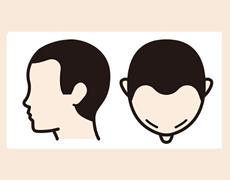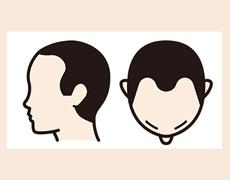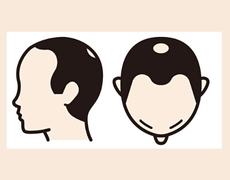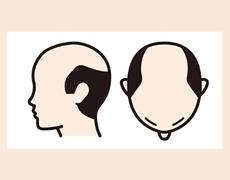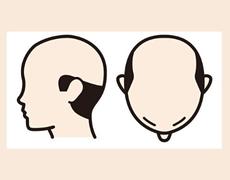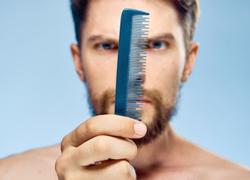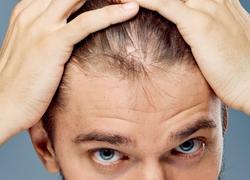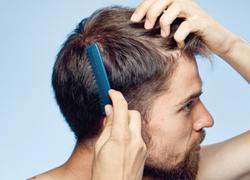Male hair loss
Everything you need to know
Male hair loss is undoubtedly a significant blow to the psychology of men and adds several years to their appearanceAccording to the American Hair Loss Society, 2 out of 3 men begin to notice changes in their hair density by the age of 35, while there are many who notice the first signs of hair loss as early as the age of 25However, modern male hair loss treatments can slow the rate of male hair loss, keep hair follicles alive for more years, and restore density to thinning areas.
Less hair, less confidence
Hair loss has a significant impact on men's psychology. According to a study by the American Academy of Dermatology, 751% of men feel less confident when they start experiencing severe hair loss, while 6 out of 10 reveal that have received some joking comment about baldness at some point in his life. Without self-confidence, many men exhibit tendencies of anxiety, depression, antisociality and isolation.
Male pattern baldness also negatively impacts the sexual sphere, especially in young men who experience premature hair loss. Many feel that hair loss marks the end of youth and attractiveness, while others feel like they are becoming less desirable to their partners resulting in a decrease in their self-esteem.
Hair loss can also have an impact on a man's professional life. Studies have shown that some employers avoid hiring men who are balding or are headed for baldness because they look older and exude a less powerful and dynamic profileAt the same time, many men who suffer from severe hair loss claim that they often avoid social and professional outings due to embarrassment and reduced self-confidence in the face of colleagues with thick hair.
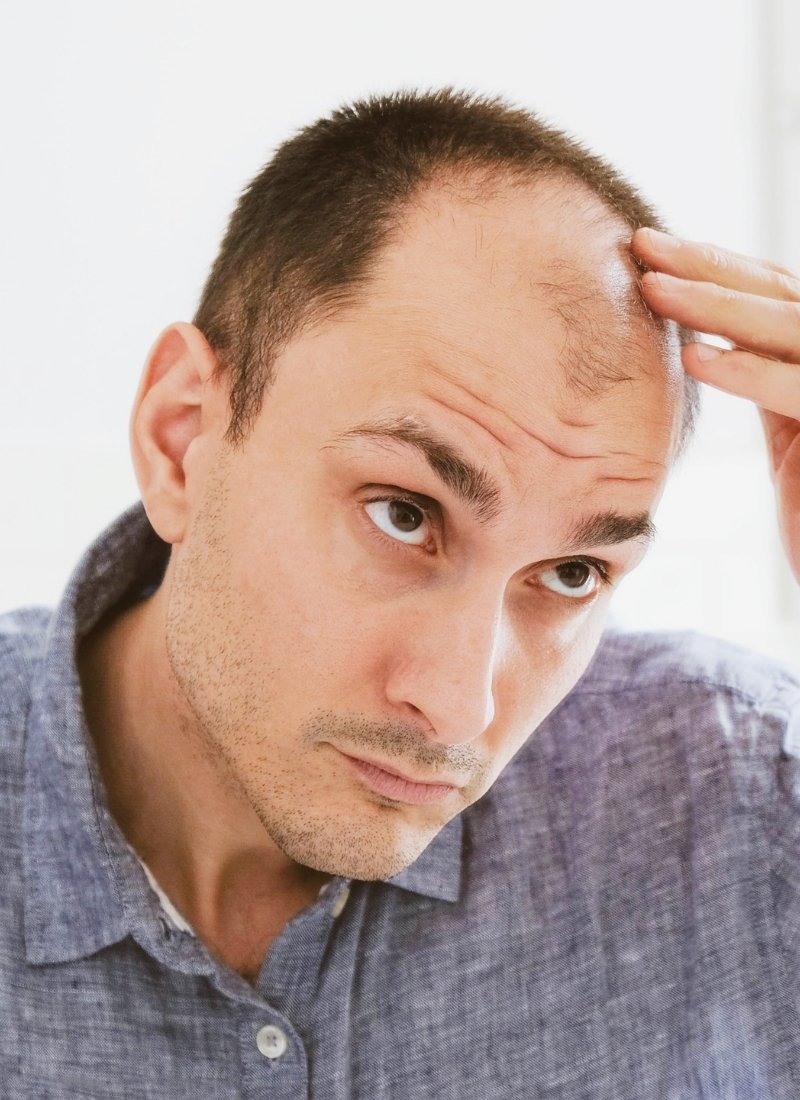
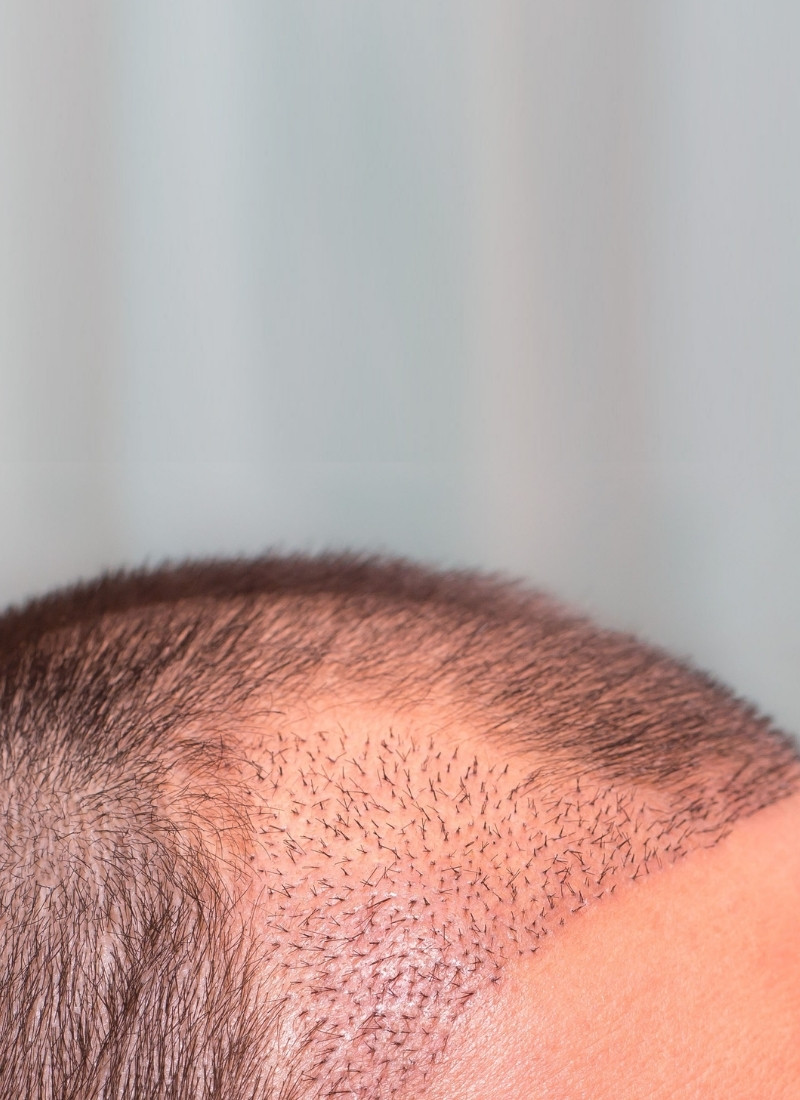
Male hair loss treatments
Male pattern baldness is a slow-growing condition that can take months, years, or even decades to lead to baldness (IF it does). If you start a hair loss treatment program as soon as you notice a receding hairline or thinning hair on your scalp, you have a better chance of keeping your hair for many years to come. Modern male pattern baldness treatments they stop the progression of hair loss, keep hair follicles active for more years, but also offer hair regrowth in thinning areas.
In its early stages, male pattern baldness can be effectively stopped with: medication and to be combined with autologous PRP mesotherapy which provides intensive nourishment to the hair follicles and enhances hair growth. For the most advanced stages of hair loss, the minimally invasive method of hair transplant with the FUE technique that guarantees a permanent result. On the contrary, for cases that are deemed unsuitable for hair transplantation, the painless and safe method of medical tattooing can be applied Scalp Micropigmentation (SMP) that offers a density effect especially for men who have adopted the shaved look.
Androgenetic alopecia
Androgenetic alopecia, or male pattern baldness, is the most common form of hair loss in men, accounting for 951% of male pattern baldness cases. It is hereditary and is due to the sensitivity of hair follicles to androgens (male hormones), specifically dihydrotestosterone. Dihydrotestosterone (or DHT for short) is a byproduct of testosterone and in men who are genetically predisposed, it causes hair follicles to shrink and weaken, resulting in them producing increasingly fine hair. This process is called “miniaturization” and gradually leads to the end of the hair follicles’ life cycle. In America alone, it is estimated that over 35 million men suffer from androgenetic alopecia!
Hair loss in men can start at any time after puberty, but there are times when it appears after the age of 30-40. In general, however, the percentage of men suffering from male pattern alopecia increases with age: approximately 20% suffer at the age of 20, 30% at the age of 30 and 40% at the age of 40. Androgenetic alopecia affects all men in the world regardless of race, ethnicity or social class or educational level. In its early stages, androgenetic alopecia is usually treated with conservative treatment, while in more advanced stages with the invasive method of hair transplantation.
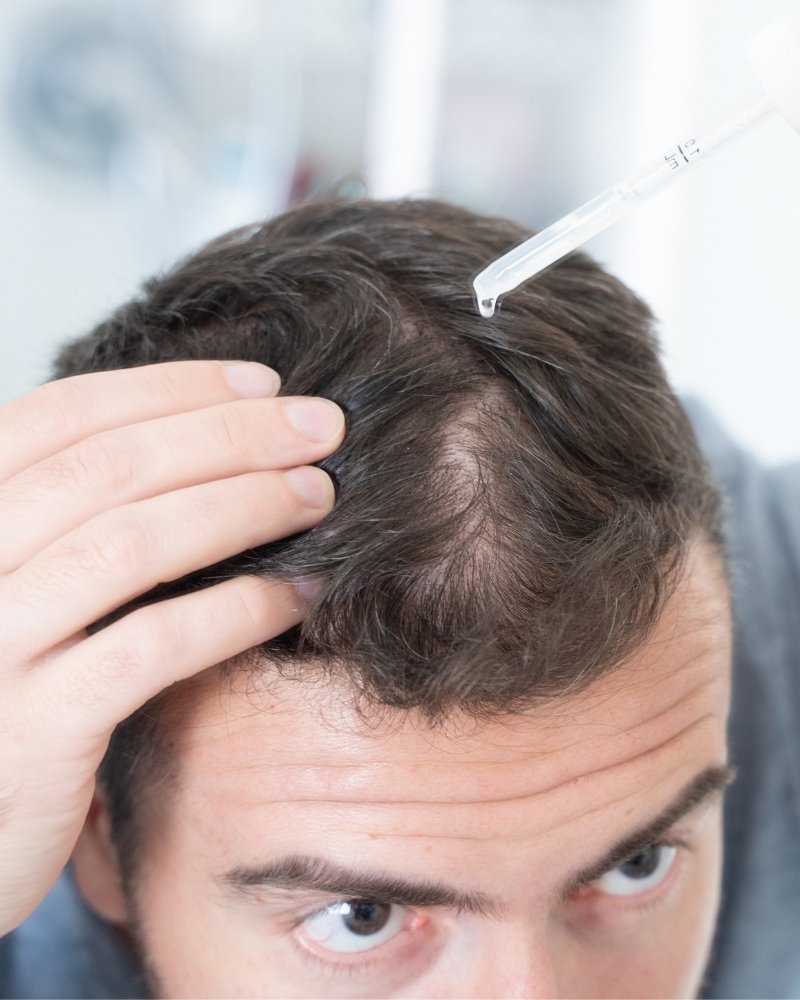
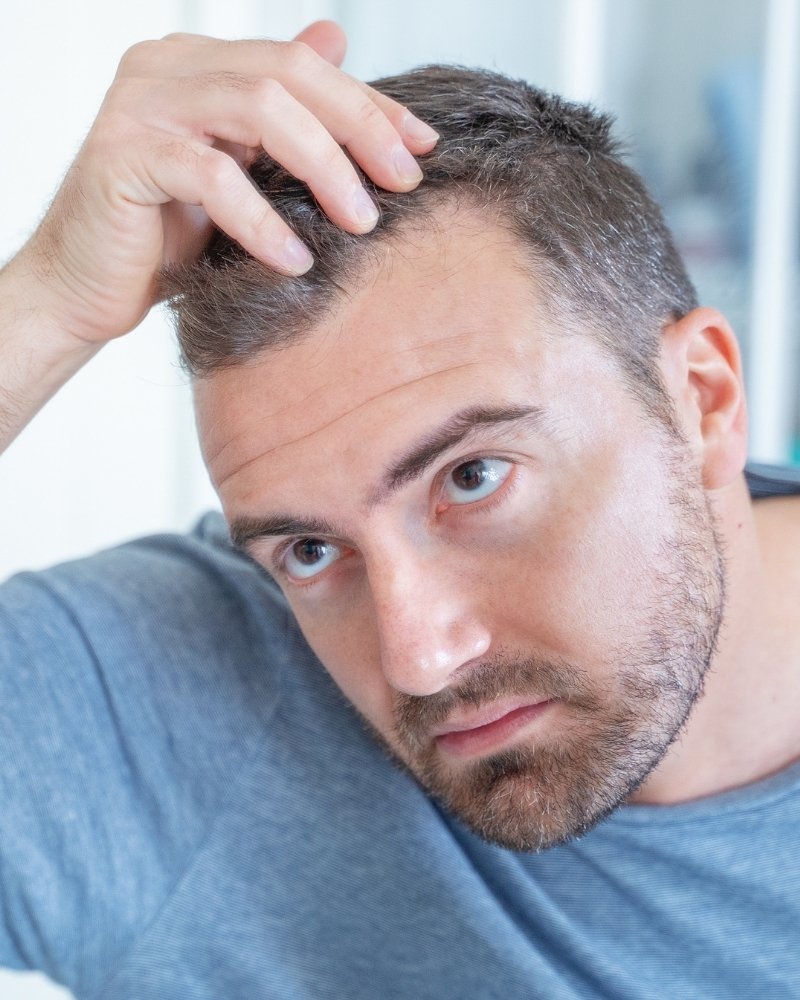
Evolution of male hair loss – Norwood Scale
Every hair on the scalp goes through a life cycle. However, in the case of androgenetic alopecia, the life cycle becomes shorter and the hair follicle gradually shrinks. The result is that the hairs it produces become increasingly finer, shorter and weaker, until the life cycle for each hair is complete and no new hair grows from that point, gradually leading to visible hair thinning.
Typically, androgenetic alopecia first becomes visible in the receding temples, resulting in an "M"-shaped frontal hairline, and progresses backward as the years go by. The stage of male pattern alopecia is determined based on the Norwood scale, which has been used since the 1950s to classify androgenetic hair loss. According to the Norwood scale, androgenetic alopecia is divided into 7 stages.
Level I
No significant hair loss or receding hairline.
Level II
Slight receding of the forehead line in the temple area.
Level III
Significant receding of the forehead line, resembling the letter “M” or “U” in shape. At the same time, thinning may begin at the top of the head (stage III Vertex).
Level IV
A sharp receding of the frontal line, which now takes on a semicircular shape. At the same time, the bald area on the top of the head grows and a thin strip of hair remains separating it from the frontal hairline.
Level V
More intense thinning at the front and top of the head, while the hairline separating them becomes even thinner.
Level VI
The hairless areas of the temples and the crown of the head merge, while the thinning extends towards the back of the scalp.
Level VII
Hair growth is now limited only to the side and back area of the scalp.
4 symptoms to understand if you will go bald
When hair loss begins, the major question that arises for every man is "will I go bald?" Whether you will reach the point of becoming bald or not, it depends on your genes. The biggest problem with hair loss is that the longer you wait to see how it progresses, the harder it becomes to reverse its progression. If you delay treating hair loss, it is very likely that you will have difficulty maintaining thick hair as you grow older. See what are the signs that warn you that you have started losing your hair, so you can act in time.
Excessive hair loss
This may sound obvious, but excessive hair loss is a very common symptom that you are starting to lose your hair. You should remember that the normal rate of hair loss is the loss of about 100 hairs per day. Therefore, it is normal to find a few hairs on your pillow or brush. However, if you start to notice a lot of hairs falling left and right on the floor of your house or collected in the shower drain, then don't ignore them.
Retreat of the front line
A receding frontal hairline is a classic sign of androgenetic alopecia. Unfortunately, it’s a sign that many men ignore until it becomes very severe, either because they don’t notice it developing or because they’re uncomfortable with it. You may notice that your frontal hairline is starting to recede if certain hairstyles reveal more forehead skin than you’re used to seeing. You may also notice that your frontal hairline is starting to resemble the letter “M.”
Visible scalp
Androgenetic alopecia can cause even the thickest hair to thin so much that the scalp begins to show, especially when the hair is wet or has been styled. This is because even if the frontal hairline has not receded at all, there may be thinning on the top of the head. You can see this by looking at the back of your head in a mirror.
Slower hair growth
Hair grows about 15 centimeters per year, which is about 1-1.5 centimeters per month. Although there are currently no scientific studies confirming that androgenetic alopecia affects the speed of hair growth, as it affects the total number and density of hair, you may very well find that your hair does not grow as quickly after a short haircut. You may also notice that the new hairs are thinner than the old ones, due to the effect of dihydrotestosterone on the hair follicles.
Other causes of male hair loss
In addition to androgenetic alopecia, hair loss can have other causes, but in many cases, if they are treated in a targeted manner, hair loss stops and hair density is restored.
Health disorders & medication
Temporary hair loss can be caused by certain health conditions, such as thyroid disease or anemia. Certain medications – especially those used to treat cancer, depression, arthritis, high blood pressure and heart disease – can also cause hair loss, while radiation therapy and chemotherapy can cause widespread hair loss throughout the body.
Stress
Situations of shock or severe trauma can cause hair loss even in the healthiest scalp, as they abruptly stop the growth phase of hair follicles and prematurely put them into a resting phase. Hair loss is observed approximately 2-3 months after the stressful event and most of the time hair growth is restored after a period of time.
Lack of sleep
Insufficient rest deprives the body of the ability to recharge its batteries and repair damage. Lack of sleep initially causes hair to lose its shine, but it can also gradually reduce blood circulation to the scalp, increasing the rate of hair loss.
Steroid use
Many athletes and bodybuilders choose to use growth hormones and steroids to enhance their performance, but these are substances that negatively affect hair growth.
Poor diet
A diet low in vitamins and minerals can negatively affect hair growth. It is important to follow a diet rich in protein, iron, Omega-3 fatty acids, zinc and selenium.
Smoking
Smoking has an impact on the heart and circulatory system, which affect hair health. In addition, smoking burdens the endocrine system, which in turn reduces the body's ability to produce collagen, as well as certain oils that are useful for hair growth.
Book your appointment!
Frequently Asked Questions
The first is hidden.
Your content goes here. Edit or remove this text inline or in the Content settings module. You can also style every aspect of this content in the Design settings module and even apply custom CSS to this text in the Advanced settings module.
Why does male pattern baldness occur?
The most common cause is androgenetic alopecia, which is related to heredity and hormones (mainly dihydrotestosterone – DHT). Factors such as stress, poor diet and certain medications can worsen the condition.
At what age does it usually start?
Hair loss can start as early as age 20, but is more common after age 30–35. The speed and extent of hair loss varies from person to person.
Are there treatments that help with male hair loss?
Yes. There are drug treatments (such as minoxidil and finasteride), mesotherapy or PRP treatments, special shampoos, and hair transplantation. The appropriate combination depends on the case.
Can hair loss be prevented?
It can't always be prevented, especially when it's hereditary. However, a healthy diet, proper hair care, avoiding excessive stress, and early diagnosis can delay its progression.
Can hats cause hair loss?
Hair growth depends on blood circulation to the hair follicles. Therefore, a hat cannot cause hair loss unless it is so tight that it blocks blood circulation.
Does testosterone cause hair loss?
Many people believe that bald men have high testosterone. In fact, research has shown that men with hair have exactly the same testosterone levels as men without hair. However, there is a link between dihydrotestosterone (a byproduct of testosterone) and hair loss. This hormone can shorten the life cycle of hair, and if hair follicles are sensitive to it, then hair loss can occur. What determines the sensitivity of hair follicles to the action of dihydrotestosterone? It depends on each man's genes.
Does frequent use of hair gel cause hair loss?
Gels, sprays, hair mousses and styling products in general can make your hair greasy, dry or strip it of its natural oils, but they cannot cause hair loss. If you use a large amount of product, make sure to remove it well when shampooing so that the product does not accumulate on the scalp and possibly cause a skin reaction, which in any case will not lead to baldness.
Are hair loss genes inherited from the mother?
Hair loss is a polygenic disease, meaning that it must be present in several family members to be inherited. Both male and female pattern alopecia do not come from just one side of a family. They can come from either the mother, the father, or both. If there is a history of hair loss in your family, then you should regularly observe your hair for any changes in hair density and quality, so that you can seek timely treatment and slow down the rate of hair loss.

